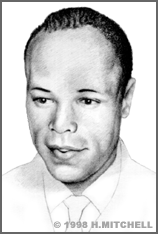Meredith Gourdine
For over thirty years, Meredith C. Gourdine was a pioneer researcher and inventor in the field of electrogasdynamics.
Gourdine was born in Newark, New Jersey. He ran track while attending Cornell University and won a silver medal in the long jump at the Helsinki Olympic Games in 1952. His academic curriculum centered on Engineering Physics, in which he earned a BS from Cornell in 1953 and a PhD from the California Institute of Technology (CalTech) in 1960. In his last three years at CalTech, Gourdine was already Senior Research Scientist at their Jet Propulsion Laboratory.
Gourdine was one of the first, and remains one of the most respected scientists in electrogasdynamics, which is the generation of energy from the motion of gas molecules that have been ionized (electrically charged) under high pressure. Gourdine's specialty was to invent very practical applications for this rather abstruse procedure.
Gourdine is best known for his invention of various electrostatic precipitator systems (first patents granted in 1971-1973), including "Incineraid," which helps to remove smoke from burning buildings, and a method of removing fog from airport runways (patented in 1987). These systems clear the air by introducing a negative charge to airborne particles. Once negatively charged, the particles are electromagnetically attracted to the ground, and so they drop down to have their former place taken by fresh air.
Gourdine was also granted patents for applications of electrogasdynamics to circuit breakers, acoustic imaging, air monitors, and coating systems, as well as the Focus Flow Heat Sink, which is used to cool computer chips. He earned over 30 U.S. patents throughout the course of his life.
Gourdine also focused his efforts on heating and cooling systems based on the conversion and transfer of thermal energy, with patents granted from 1989 to 1996. In 1994, he was inducted into the Engineering and Science Hall of Fame. Toward the end of his life, Gourdine suffered from diabetes and lost his sight as well as one leg to the disease. He died on November 20, 1998 from multiple strokes.


